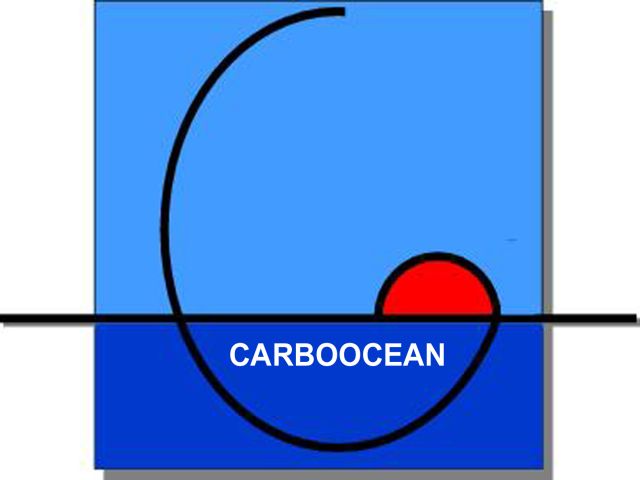Rationale
Emissions of CO2 to the atmosphere have increased atmospheric pCO2 and caused, on the global
scale, an increased flux of CO2 across the air-sea interface relative to pre-industrial times. The
net uptake results in a temporal increase in the within-ocean inventory of carbon. The locations
where the extra or anthropogenic carbon (Cant) accumulates are determined both by the
location where the net air-sea flux of CO2 (Theme 1) is perturbed over its pre-industrial state,
and by the action of ocean circulation in redistributing Cant. Temporal changes in ocean
circulation, for example those associated with climate change (Theme 5), as well as
biogeochemical feedbacks (Theme 4) can themselves affect the net inventory change of CO2
which is also affected by exchanges with land and the coastal seas (Theme 3). Hence the postindustrial
oceanic carbon inventory change is quantitatively equivalent to the oceanic carbon sink
and reflects the integral effects of direct and indirect human perturbations of the carbon cycle.
The inventory of Cant within the ocean interior is predicted by ocean carbon cycle models
but it can also be estimated from carbonate system measurements made within the ocean interior
during hydrographic cruises. The latter requires detecting the relatively small Cant signal against
a large and variable natural oceanic background. A family of methodological approaches, which
rely on a broad set of sometimes untested assumptions, has been developed and widely
published. These empirical methods allow the total amount of Cant added since ~1750 to be
quantified. In recent years, the historical oceanic database has become sufficiently extensive and
accurate to permit the direct estimation of inventory changes over shorter (e.g. decadal)
timescales. High-quality data sets collected during the early 1980s as well as the 1990s already
exist for the Atlantic Ocean. The ability to detect inventory change over decadal timescales holds
considerable promise for providing independent and less assumption-dependent quantification of
the ocean carbon sink.
The latest observation-based assessments made using data collected by the WOCE-JGOFS
Global CO2 Survey suggest that the Atlantic Ocean in 1994 contained about 42% of the
global ocean inventory of Cant. (North Atlantic ~ 28%). This far exceeds the Atlantics
contribution to global ocean surface area (23%). There remains however considerable
disagreement, both between different models and between models and observation-based
estimates, as to both the exact amount of Cant stored within the Atlantic and, especially, the
locations where the uptake and storage takes place.
Several European nations as well as Canada, the USA, Australia, China and Japan have
plans to conduct large-scale hydrographic surveys, involving measurements of carbon
inventories, over the next 5 years. CARBOOCEAN will interact closely with these programs
through the IOCCP, and will take the lead in coordinating international efforts within the
Atlantic Ocean where European field work is focussed.
The temporal variability of oceanic oxygen inventories are also of direct relevance to
carbon cycle assessments, because of the utility and high-profile applications (e.g. in the last
IPCC assessment) of atmospheric oxygen time-series to separately quantify terrestrial and
oceanic carbon sinks. A fundamental assumption until recently was that interannual and lowerfrequency
changes in oceanic oxygen inventories are negligible. Recent modelling studies,
together with limited observational evidence, have suggested that there may be significant
variability or trends in oceanic oxygen inventories that are associated with long-term changes in
ocean circulation. These could have a large influence on the interpretation of global carbon sinks
involving corrections to estimates of the global terrestrial sink of 0.2 to 0.7 PgC/yr. Model
simulations suggest that climate-circulation feedbacks during this century could induce even
larger, systematic trends in oceanic oxygen inventories. If the utility of the atmospheric oxygen
time-series method is to be preserved, measurement-based constraints on oceanic oxygen levels
as well as of inorganic carbon inventories will be required. Such measurements aid not only the
assessment of global carbon sinks, but can also be useful in detecting changes in the ocean's
thermohaline circulation. Such circulation changes, would in turn, affect future oceanic carbon
uptake and storage. Hence there is a close coupling between studies of oceanic oxygen and
carbon inventories.
Theme 2 will take a comprehensive approach to the problem of detecting and quantifying
changing ocean carbon inventories. Under this theme, a European contribution to a global,
international analysis will be undertaken. Theme 2 will collect and examine historical data and
support collection of new data within the Atlantic Ocean making using of nationally-funded
hydrographic cruises. New approaches to determining Cant will be developed and validated
through an unprecedented collaboration between modelling and observational groups. New
technologies suited to long-term measurement of oxygen (and potentially carbon) inventories
will be developed and tested. The ocean inventory assessments will be applied to testing model
performance. All of these activities involve innovation (new techniques, new approaches, new
data) and integration (observation-model; international; atmosphere-ocean-terrestrial via oxygen
budget).
Objectives
O2.1 Quantify the Atlantic and Southern Ocean carbon sink, and its decadal change, through
highest accuracy measurement of the changing inventories of inorganic carbon and carbonrelated
tracers.
O2.2 Assess the ability of prognostic models to represent the observed changes.
O2.3 Develop and critically evaluate new observational approaches for constraining oceanic carbon
and oxygen inventory changes.

